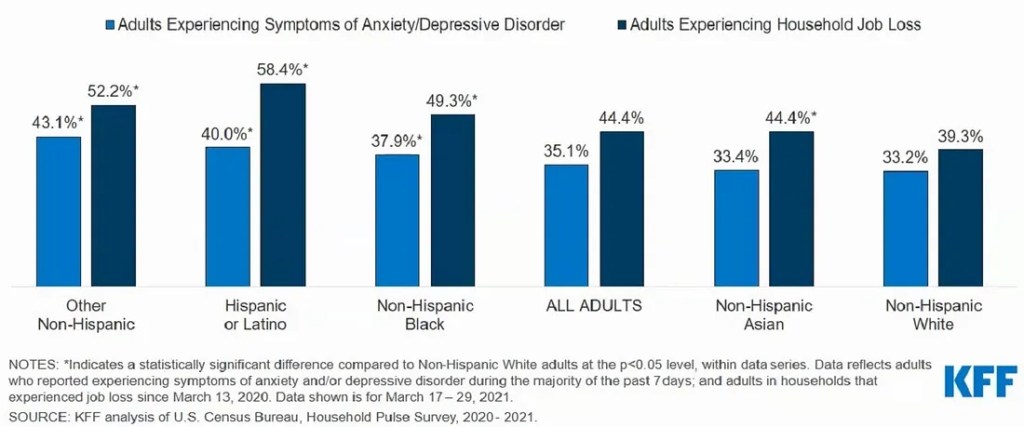
Missed deadlines, chronic absenteeism, conflicts among colleagues: Even before the COVID-19 pandemic, depression and anxiety took a toll in the workplace, costing the global economy about $1 trillion every year in lost productivity.
The pandemic and economic downturn have exacerbated the problem. Throughout the pandemic, about four in 10 adults in the U.S. have reported symptoms of anxiety or depressive disorder, up from one in 10 between January 2019 and June 2019.
Nirmita Panchal, a senior policy analyst at the Kaiser Family Foundation, highlighted this trend in remarks at “Mental Health in Communities of Color: Economic Implications and Policy Solutions,” a May 26 event hosted by the New York Fed.
She pointed out that nearly half of adults who lost their jobs during the pandemic have experienced poor mental health. Further, Hispanic and Black adults experienced relatively higher rates of both depression/anxiety and household job loss.

Providing more care to people experiencing mental health challenges could have significant economic returns. A World Health Organization-led study estimates that for every $1 put into scaled-up treatment for common mental disorders, there is a $4 return.
With these trends in mind, we asked mental health professionals at our May 26 event what additional support employers, community organizations, and governments might offer. Some of their responses:
- Cultural competence: Panelists stressed that partnerships with existing organizations that have cultural cache within a community are key to reaching traditionally underserved and distressed communities. Local organizations possess the cultural and linguistic competency and understand the needs of community. Often, these organizations are staffed by community members.
- Bringing counseling to where people are: Using a $100 million FEMA grant, New York State is working with churches and community groups to provide mental health services and hiring from those communities to provide it. New York is also targeting the 230 school districts with the most poverty in the state to provide mental health support in schools, an effort led by Ann Marie Sullivan, the state’s commissioner of mental health. Speaking about the importance of school-based services, panel participant Alfiee M. Breland-Noble said, “The by-product is that what the kids learn at school, they’re taking home.”
- Rethinking the mental health workforce: With demand for mental health services outstripping the professionals available, mental health providers can provide skills training for and build greater awareness among teachers, program staff at community organizations, members of the clergy, and others who deal with the public regularly. “Cognitive therapy can be taught,” said Adam Brown, associate professor of clinical psychology and vice provost for research at The New School. Part of this “expansion of the workforce” could include the creation of career ladders for those who come to the field this way, he said.
- Show employers the return on investment: Employers must understand that there are ways to get people mental health care, such as combining job coaching and therapy, that improve workers’ job performance, said Sherry Glied, dean of the Wagner Graduate School of Public Service at NYU.
- Broad-based programs work: Project Liberty, a state and local effort to provide mental health services to New Yorkers after 9/11, was effective in reaching the Black community, Glied said. Coming out of the pandemic, a similar broad-based program targeting at-risk communities could be similarly effective, she said.
The bottom line from the panel: “Poor mental health is as expensive as poor physical health,” Glied said.
This article was originally published by the New York Fed on Medium.
The views expressed in this article are those of the contributing authors and do not necessarily reflect the position of the New York Fed or the Federal Reserve System.










